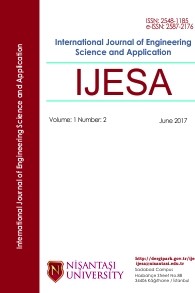A Review on Radiowave Propagation Models for Very High Frequency and Ultra High Frequency Band
A Review on Radiowave Propagation Models for Very High Frequency and Ultra High Frequency Band
Radiowave Propagation Models, , VHF Band, UHF Band, Attenuating Factors Radiowave Propagation,
___
- [1] Saakian A.S.,(2011). Radiowave Propagation Fundamentals. Artech House.
- [2] Harris (2000). Radio Communications on the Digital Age: VHF/UHF Technology. Harris Corporation, USA, vol. (2).
- [3] Carr J.J., (2001). Practical Antenna Handbook.4th Edition. McGraw-Hill
- [4] Biebuma J.J., (2014). Telecommunication System Design. Celwill Nigeria Ltd, Idaminabo Close, Abuloma, Port Harcourt.
- [5] Ayekomilogbon O., Famoriji O., &Olasoji O., (2013). UHF Band Radio Wave Propagation Mechanism in Forested Environments for Wireless Communication Systems, vol. 3(7), pp 11-16.
- [6]Ayekomilogbon O.T., Famoriji .J.,&Olasoji O.Y.,(2013). Evaluation and Modelling Of UHF Radio Wave Propagation in a Forested Environment. International Journal of Engineering and Innovative Technology (IJEIT), vol. 2(12), pp 101-106.
- [7] Armoogum .V.,Soyjaudah K.M.S., Mohamudally N., & Fogarty T., (2010). Propagation Models and Their Applications in Digital Television Broadcast Network Design and Implementation. Trends in Telecommunications Technologies, pp 165-185.
- [8] Sauders S.R., (2005). Antenna and Propagation for Wireless Communication Systems. Wiley.
- [9] IEEE (2018). IEEE Standard Definitions of Terms for Radio Waves Propagation. IEEE Antenna and Propagation Society. New York, USA, IEEE Std 211
- [10]Biebuma J.J., &Omijeh B.O., (2013). Path loss Model Using Geographic Information System (GIS). International Journal of Engineering and Technology, vol. 3(3), pp 269-275.
- [11] Rick T., &Mathar R., (2007). Fast Edge Diffraction-Based Radiowave Propagation Model for Graphics Hardware. Proceeding Of The 2nd IEEE International ITG Conference On Antenna (INICA), Munich, Germany.
- [12] Parmar K. J., &Nimavat V.D., (2015). Comparative Analysis of Path Loss Propagation Models on Radio Communication. International Journal of Innovative Research of Computer and Communication Engineering, vol. 3(2), pp 840-844.
- [13] Bolli .S.,& Khan M.Z.A., (2015). A Novel LMMSE Based Optimized Perez-Vega Zamanillo Propagation Path Loss Model In VHF/UHF Bands For India. Progress in Electromagnetic Research, vol. 63, pp 17-33.
- [14] Popoola J.J., &Adesanya A.T., (2018). A Versatile Wave Propagation Model for Very High Frequency Broadcasting Band in Vegetation and/or Rocky Environment. International Journal of Engineering Science and Application, vol. 2(1), pp 18-26.
- [15] Temaneh- Nyah C., &Nepembe J.,(2014). Determination of a Suitable Correction Factor to a Radio Propagation Model for Cellular Wireless Network Analysis. Fifth International Conference on Intelligent Systems, Modelling and Simulation, IEEE Computer Society, pp 175-182.
- [16] Anderson H.R., (2003). Fixed Broadband Wireless System Design: The Creation Of Global Mobile Communication, John Wiley & Sons, Inc., New York, NY.
- [17] Sharma P.K & Singh R.K., (2010). Comparative Analysis of Propagation Path Loss Models with Field Measured Oata, International Journal of Engineering, Science and Technology, vol. 2(6), pp 2008-2013.
- [18] Poonle A.A., &Owolabi O.J., (2019). Path Loss Modelling Of UHF Radio Wave Propagation in Ado-Ekiti, Nigeria. ABUAD Journal of Engineering Research and Development (AJERD), vol. 2(1), pp 90-102.
- [19] Ogbulezie J.C., Akonjom N.A., Ojomu S.A., Ezugwu A.O., &Igajah I.E., (2016). A Review of Path Loss Models for Uhfradiowaves Propagation: Trends and Assessment. International Journal of Research in Engineering and Science, vol 4(7), pp 67-75.
- [20] Sati G., & Singh S.,(2014). A Review on Outdoor Propagation Models in Radio Communication. International Journal of Computer Engineering & Science, vol. 4(2), pp 64-68.
- [21] Garah. M., Djouane .L.,Oudira .H., &Hamdiken .N., (2016). Indonesian Journal of Electrical Engineering and Computer Science. vol. 3(1), pp 126-135.
- [22]Mardeni .R, & Kwan K.F., (2010). Optimization of Hata Propagation Prediction Model in Suburban Area in Malaysia. Progress in Electromagnetic Research C, vol. 13, pp 91-106.
- [23] Ebhota C.V., Isabona J., & Srivastava V.M., (2018). Base Line Knowledge on Propagation Modelling and Prediction Techniques in Wireless Communication Networks. Journal of Engineering and Applied Sciences, vol. 13(7), pp 1919-1934.
- [24] Nazmat T.S.B., Nasir. F., Segun I.P., Muhammed A.S., Abdulkarim A.O., & Carlos T.C., (2018). Path Loss Predictions For Multi-Transmitter Radio Propagation In VHF Bands Using Adaptive Neuro-Fuzzy Interference System. Engineering Science and Technology, an International Journal, Elsevier, pp 679-691.
- [25] Milanovic .J.,Rimac-Drlje S., &Mayerski .I., (2010). Radio Wave Propagation Mechanisms And Empirical Models For Fixed Wireless Access Systems, Technical Gazette, pp 43-52.
- [26] Sarkar T.K., Zhong J., Kim K., Medouri A., & Salazar-Palma M., (2003). A Study of Various Propagation Models for Mobile Communication, IEEE Antennas and Propagation Magazine, vol. 45(3), pp 51-82.
- [27] Rappapot T.S.,(2002). Wireless Communication Principles and Practice, 2nd Edition, New York. Pearson Education.
- ISSN: 2548-1185
- Başlangıç: 2016
- Yayıncı: Nişantaşı Üniversitesi
PHYTOREMEDIATION OF USED ENGINE OIL CONTAMINATED SOIL USING LEMON GRASS.
John OGUCHE, Sunday AGBO, Toyese OYEGOKE, Daniel EMENİRU
A Review on Radiowave Propagation Models for Very High Frequency and Ultra High Frequency Band
Dark Energy Classification in Higher Dimensional FRW Model According to State
